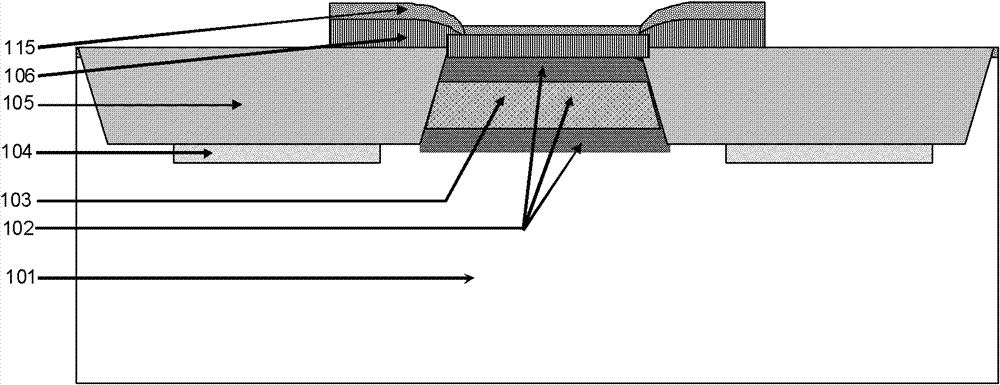Method of eliminating etching residue of emitting electrode polycrystalline silicon in duotriode type transistor technology
A bipolar transistor and etching residue technology, which is applied in semiconductor/solid-state device manufacturing, electrical components, circuits, etc., can solve the problems of emitter polysilicon etching residue, etc., so as to solve the etching residue and reduce the risk of leakage , the effect of shortening the distance
- Summary
- Abstract
- Description
- Claims
- Application Information
AI Technical Summary
Problems solved by technology
Method used
Image
Examples
Embodiment Construction
[0027] The bipolar transistor structure produced by the method for removing the emitter polysilicon etching residue in the bipolar transistor process in the present invention is as follows Figure 6 As shown, the active region consists of shallow trench field oxygen ie figure 1 The shallow trench isolation layer 105 in isolation includes a collector region, a pseudo-buried layer, a base region and an emitter region.
[0028] Such as Figure 1 to Figure 6 Shown is a schematic diagram of the device structure during the manufacturing process of the embodiment of the present invention. The method of the embodiment of the present invention, such as Figure 7 shown, including the following steps:
[0029] In step 1, a shallow trench isolation layer 105 is formed on the P-type silicon substrate 101, and a dose of 10 is implanted at the bottom of the shallow trench isolation layer 105. 15 ~10 16 cm -2 N-type ions with an energy of 5-15keV form the N-type pseudo-buried layer 104...
PUM
| Property | Measurement | Unit |
|---|---|---|
| thickness | aaaaa | aaaaa |
Abstract
Description
Claims
Application Information
 Login to View More
Login to View More - R&D Engineer
- R&D Manager
- IP Professional
- Industry Leading Data Capabilities
- Powerful AI technology
- Patent DNA Extraction
Browse by: Latest US Patents, China's latest patents, Technical Efficacy Thesaurus, Application Domain, Technology Topic, Popular Technical Reports.
© 2024 PatSnap. All rights reserved.Legal|Privacy policy|Modern Slavery Act Transparency Statement|Sitemap|About US| Contact US: help@patsnap.com










